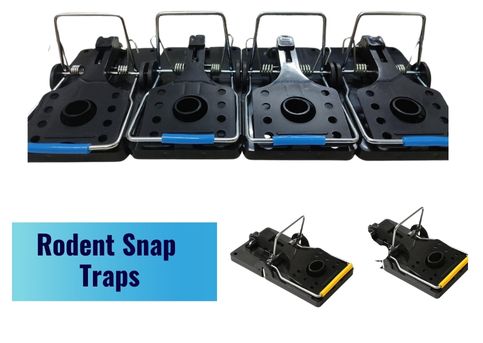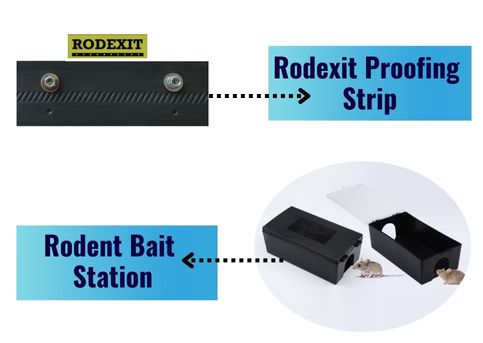"Snap Traps: The Ultimate Non-Chemical Solution for Rodent Control"
In addition to being unwelcome visitors, rodents can spread illness and cause serious property damage. To keep people safe and healthy, effective pest control services in Hyderabad and Pune are necessary. Despite their widespread use, chemical methods aren't always the best. Presenting snap traps, a tried-and-true, non-toxic way to get rid of rodent problems. A safer and healthier environment is guaranteed when you choose the best pest control solution, whether you're dealing with rats or need cockroach treatment in Pune.
This blogpost explores why snap traps remain a top choice for rodent control, how to use them effectively, and why they are a safe and sustainable alternative to chemical-based rodent-control solutions
Why Choose Snap Traps Over Chemical Methods In Rodent Control?
Snap traps offer several advantages that make them a reliable option for rodent control:
- Safety: Unlike chemical baits, snap traps pose no risk to children, pets, or non-target wildlife when used properly.
- Eco-Friendly: They don’t introduce toxins into your home or the environment.
- Cost-Effective: Snap traps are affordable and reusable, making them an economical choice for both small and large rodent infestations.
- Immediate Results: Snap traps provide a quick and humane solution to rodent problems without prolonged suffering of the affected individuals.
Types of Snap Traps for Every Need
Snap traps have evolved over time, offering various designs to suit different preferences and requirements:
- Traditional Wooden Traps: These classic traps feature a wooden base and metal spring mechanism. They are reliable, easy to set up, and cost-effective.
- Plastic Snap Traps: Made of durable plastic, these traps are easier to clean and reset while functioning similarly to traditional designs.
- Humane Snap Traps: These are specially designed to ensure quick and painless deaths, reducing unnecessary suffering of the rodents.

How to Use Snap Traps Effectively
To get the most out of your snap traps, follow these practical tips:
- Bait Selection: Use attractive baits like peanut butter, dried fruits, or cheese. Apply only a small amount of the food bait to avoid allowing rodents to steal it without triggering the trap.
- Strategic Placement: Rodents tend to travel along walls and hide in dark corners. Place traps in these areas, as well as behind appliances, in attics, or near food storage areas.
- Pre-Baiting: Before setting the traps, leave them baited but unset for a day or two-allowing rodents to become familiar with the trap, increasing the likelihood of success.
- Safety Measures: Place traps in locations inaccessible to children and pets. You can also use snap traps inside tamper-resistant rodent bait stations for added safety.
- Minimize Human Scent: Wear gloves while handling traps to avoid transferring human scent, which can deter rodents.
Snap Traps in Action: Step-by-Step Setup
- Choose the Right Trap: Select the trap type that best suits your needs and environment.
- Prepare the Bait: Apply a pea-sized amount of the food bait on the trigger plate.
- Set the Trap: Carefully pull back the spring and secure it in the trigger mechanism.
- Position the Trap: Place the trap perpendicular to walls where rodents are active, with the trigger end facing the wall.
- Check Regularly: Inspect the snap traps daily, remove caught rodents promptly, and reset as needed.
Benefits of Snap Traps Over Other Non-Chemical Methods
While other non-toxic methods like live traps or repellents exist, snap traps stand out for their efficiency and reliability:
- No Need for Rodent Release: Unlike live traps, snap traps eliminate the need to release trapped rodents, which can be challenging and potentially harmful if not done correctly.
- Direct Action: Snap traps address the problem immediately, reducing the chances of re-infestation.
- Minimal Maintenance: Unlike repellents or electronic devices, snap traps require little upkeep beyond resetting and occasional cleaning.
Pairing Snap Traps with Preventative Measures
Snap traps work best when combined with preventative strategies to create a rodent-proof environment:
- Seal Entry Points: Inspect your home for cracks, gaps, and holes that rodents might use to enter. Seal these openings with materials like steel wool, hardware cloth, or caulk. Seva Facility Pest Control Services offers RodeXit rodent seal installation at an affordable cost to prevent rodent entry from below doors and shutters. RodeXit is made of Santoprene polymer and has ten steel wires inside that deter rodents from chewing or damaging it.
- Improve Sanitation: Keep food stored in sealed containers, dispose of garbage regularly, and clean up spills immediately to remove food sources.
- Declutter: Rodents love hiding in clutter. Organize storage areas and remove unnecessary piles of paper, cardboard, or other materials that offer nesting material and a space to hide for rodent.
- Fix Leaks: Eliminate standing water sources by repairing leaks and ensuring proper drainage.
For comprehensive protection against both rodents and cockroaches, especially in food-sensitive environments, explore our Cockroach Control Pune Food Safety solutions.

Real-Life Example: Snap Trap Success Story
Imagine a homeowner struggling with a rodent infestation in their attic. Instead of opting for chemical baits, they deploy a series of snap traps:
- They start by sealing entry points and decluttering the attic.
- Snap traps are placed strategically along walls and baited with peanut butter.
- Over a few days, the traps catch multiple rodents, effectively resolving the issue.
This simple, non-toxic approach not only removes the rodent infestation but also prevents future rodent problems.
Common Mistakes to Avoid
Even the best traps can fail to trap rodents if not used correctly. Avoid these common errors:
- Using Too Much Bait: Excess Bait makes it easier for rodents to take the bait without triggering the trap.
- Poor Placement: Traps placed in open areas or far from rodent activity are less effective.
- Ignoring Human Scent: Rodents are wary of unfamiliar smells, so always handle traps with gloves.
Conclusion: A Safer, Greener Solution
Snap traps are a time-tested, eco-friendly solution for controlling rodent infestations. They offer safety, affordability, and effectiveness without the risks associated with chemical pesticides. By combining snap traps with preventative measures like sealing entry points and improving sanitation, you can maintain a rodent-free environment.
Say goodbye to harmful chemicals and hello to a safer, sustainable approach to rodent control !!!!!
Wishing you a pest-free and safe environment,
Hiraman Rathod
Seva Facility Pest Control Services
Phone: 91 9112003300
Email: info@sevafacility.com

